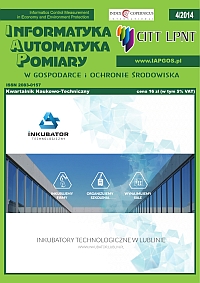PRZETAPIANIE JAKO METODA DEKONTAMINACJI SKAŻONEGO ZŁOMU Z ROZBIÓRKI ELEKTROWNI ATOMOWEJ ZAMKNIĘTEJ PO AWARII
##plugins.themes.bootstrap3.article.sidebar##
Open full text
Numer Tom 4 Nr 4 (2014)
-
OBLICZENIA EKSPOZYCJI ZEWNĘTRZNEJ PODCZAS DEMONTAŻU I SEGMENTACJI GENERATORA PARY
Martin Hornáček, Vladimir Necas3-10
-
ANALIZA I WERYFIKACJA PARAMETRÓW TERMICZNYCH UKŁADU SCALONEGO
Maciej Frankiewicz, Adam Gołda, Andrzej Kos11-15
-
PRZETAPIANIE JAKO METODA DEKONTAMINACJI SKAŻONEGO ZŁOMU Z ROZBIÓRKI ELEKTROWNI ATOMOWEJ ZAMKNIĘTEJ PO AWARII
Andrej Slimák, Vladimir Necas16-20
-
IMPEDANCJE WŁASNE I WZAJEMNE SZYNOPRZEWODÓW PROSTOKĄTNYCH O SKOŃCZONEJ DŁUGOŚCI
Tomasz Szczegielniak, Zygmunt Piątek, Dariusz Kusiak21-24
-
TECHNOLOGIE TRANSFORMATORÓW NADPRZEWODNIKOWYCH
Łukasz Woźniak, Paweł Surdacki25-27
-
MODELOWANIE PROCESU FILTRACJI FILTREM N-WARSTWOWYM PŁYNU Z ZANIECZYSZCZENIAMI WIELOSKŁADNIKOWYMI
Andrij P. Safonyk, Oleksandr Naumchuk28-31
-
PRZEGLĄD WYBRANYCH METOD EWOLUCYJNYCH W OPTYMALIZACJI WIELOKRYTERIALNEJ
Michalina Gryniewicz-Jaworska32-34
-
EFEKTYWNY ALGORYTM EM I JEGO IMPLEMENTACJA PRZY UŻYCIU WIELORDZENIOWYCH SYSTEMÓW KOMPUTEROWYCH
Alexei Kasitskij, Peter Bidyuk, Alexander Gozhyi35-37
-
PROBLEM MODELOWANIA POWSTAWANIA KOALICJI
Victor Mashkov, Andrzej Smolarz, Volodymyr Lytvynenko38-40
-
PROBLEM ODPORNOŚCI SYSTEMU NA USZKODZENIA
Victor Mashkov, Andrzej Smolarz, Volodymyr Lytvynenko, Konrad Gromaszek41-44
-
PORÓWNANIE NUMERYCZNYCH MODELI PORTÓW LINII PASKOWEJ
Bartosz Chaber, Jacek Starzyński45-48
-
NUMERYCZNE MODELOWANIE POLA ELEKTROMAGNETYCZNEGO W UPROSZCZONYM MODELU CZŁOWIEKA
Joanna Podlodowska49-52
-
SPRZĘTOWO-PROGRAMOWA REALIZACJA SYSTEMU TRANSMISJI INFORMACJI AUDIO Z SZYFROWANIEM CHAOTYCZNYMI SEKWENCJAMI
Yuriy Bobalo, Zenon Hotra, Olexandr Hres, Ruslan Politans’kyy53-55
-
EFEKTYWNOŚĆ KOMPENSACJI MOCY BIERNEJ W ELEKTROENERGETYCZNYCH SIECIACH DYSTRYBUCYJNYCH
Andrzej Makuch56-58
-
AUTOMATYZACJA PROCESU CIĄGŁEJ KONTROLI JAKOŚCI PRZYGOTOWYWANIA BRZECZKI W DESTYLARNI
Sergiy Vorobyuk, Volodymyr Drevetskiy59-61
-
DWUMODUŁOWY SYSTEM DO PRZETWARZANIA DANYCH EEG Z WYKORZYSTANIEM ANALIZY CZYNNIKOWEJ I PSEUDOINWERSJI MOORE-PENROSE
Szczepan Paszkiel62-64
-
MONITORING I TERENOWE BADANIA JAKOŚCI POWIETRZA Z WYKORZYSTANIEM SPEKTROMETRU MASOWEGO
Łukasz Dubiel, Andrzej Wal, Marian Kuźma65-68
-
SPALANIE WĘGLI I PALIW ALTERNATYWNYCH W ATMOSFERZE TLENOWEJ
Wojciech Moroń, Krzysztof Czajka, Anna Kisiela69-72
-
WYSZUKIWANIE REGIONÓW DO OSADZENIA ZNAKÓW WODNYCH Z WYKORZYSTANIEM ‘PIXEL IMPACT FACTOR’ ORAZ KWANTYZACJI W DZIEDZINIE PRZESTRZENNEJ
Cezary Żurawski73-76
-
PORÓWNANIE I OCENA METOD AKTYWNEGO TŁUMIENIA ZABURZEŃ PRZEWODZONYCH
Marian Pasko, Marek Szymczak77-80
-
PRAKTYCZNA REALIZACJA IDEALNEGO PROSTOWNIKA DWUPOŁÓWKOWEGO
Jiří Chytil81-84
-
ZASTOSOWANIE INTERWAŁOWEJ METODY SIATEK BOLTZMANNA DO NUMERYCZNEGO MODELOWANIA PROCESU NAŚWIETLANIA LASEREM PULSACYJNYM CIENKICH WARSTW METALOWYCH
Alicja Piasecka-Belkhayat, Anna Korczak85-88
-
SYSTEM STEROWANIA RUCHEM AUTONOMICZNEGO ROBOTA MOBILNEGO
Ivan Tsmots, Iryna Vavruk, Roman Tkachenko89-93
-
CHEMICZNIE MODYFIKOWANA POLIANILINA JAKO NOWY WYPEŁNIACZ PRZEWODZĄCY W KOMPOZYTACH POLIMEROWYCH
Ewa Kolasinska, Boleslaw Mazurek94-97
-
CHARAKTERYSTYKA SEPARATORÓW Z NANOWŁÓKIEN DLA BATERII LITOWO-JONOWYCH
Michal Musil, David Pléha98-101
-
ZDALNY MONITORING KOTŁÓW DO WSPÓŁSPALANIA
Dominik Demeter, Juraj Banský102-104
-
CZY OZE SĄ KONKURENCYJNE DLA ŹRÓDEŁ KONWENCJONALNYCH
Agnieszka Wantuch, Mirosław Janowski105-108
-
WIELOWARIANTOWA ANALIZA POLA MAGNETYCZNEGO I OBLICZENIE SIŁ LEWITACJI AKTYWNEGO OSIOWEGO ŁOŻYSKA MAGNETYCZNEGO (AAMB)
Piotr Graca, Bronisław Tomczuk109-112
-
BADANIA PRZEKSZTAŁTNIKA DC/DC Z IZOLACJĄ TRANSFORMATOROWĄ PRZEZNACZONEGO DO ZASILANIA POTRZEB WŁASNYCH POJAZDÓW TRAKCYJNYCH
Marcin Parchomiuk113-116
Archiwum
-
Tom 8 Nr 4
2018-12-16 16
-
Tom 8 Nr 3
2018-09-25 16
-
Tom 8 Nr 2
2018-05-30 18
-
Tom 8 Nr 1
2018-02-28 18
-
Tom 6 Nr 4
2016-12-22 16
-
Tom 6 Nr 3
2016-08-08 18
-
Tom 6 Nr 2
2016-05-10 16
-
Tom 6 Nr 1
2016-02-04 16
-
Tom 5 Nr 4
2015-10-28 19
-
Tom 5 Nr 3
2015-09-02 17
-
Tom 5 Nr 2
2015-06-30 15
-
Tom 5 Nr 1
2015-03-31 18
-
Tom 4 Nr 4
2014-12-09 29
-
Tom 4 Nr 3
2014-09-26 22
-
Tom 4 Nr 2
2014-06-18 21
-
Tom 4 Nr 1
2014-03-12 19
-
Tom 3 Nr 4
2013-12-27 20
-
Tom 3 Nr 3
2013-07-24 13
-
Tom 3 Nr 2
2013-05-16 9
-
Tom 3 Nr 1
2013-02-14 11
##plugins.themes.bootstrap3.article.main##
DOI
Authors
Abstrakt
W artykule krótko opisano dekontaminację radioaktywnego złomu poprzez przetapianie, jako potencjalną technologię do zmniejszenia ilości metalowych odpadów radioaktywnych. Szczególną zaletą dekontaminacji poprzez przetapianie jest homogenizacja szeregu radionuklidów we wlewkach i zatężenie innych radionuklidów w żużlu i na filtrze pyłu powstających podczas procesu przetapiania, a tym samym dekontaminacji materiału podstawowego. Prezentowana praca dotyczy również oceny ekspozycji pracowników podczas przetapiania radioaktywnego złomu, jak również wpływu przetapiania na środowisko. Według uzyskanych wyników, skuteczne dawki pochłaniane przez pracowników podczas przetapiania spełniają ustawowy limit 20 mSv rocznie.
Słowa kluczowe:
Bibliografia
European Commission: Practical use of the concepts of clearance and exemption – Part I: Guidance on General Clearance Levels for Practices, Recommendations of Group of Experts established under the terms of article 31 of the Euratom Treaty: Radiation Protection No. 122, EC, Luxemburg 2000.
International Atomic Energy Agency: Application of Thermal Technologies for Processing of Radioactive Waste. IAEA-TECDOC-1527, Vienna: IAEA 2006.
International Atomic Energy Agency: Derivation of Activity Concentration Values for Exclusion, Exemption and Clearance. Safety Report Series No. 44, Vienna: IAEA 2005.
O´Sullivan, P.J.: The relevance of metal recycling for nuclear industry decommissioning programs. Proceedings of an International Conference on Control and Management of Radioactive Material Inadvertently Incorporated into Scrap Metal, Tarragona, Spain, 23-27 February 2009, Vienna: IAEA 2009.
OECD/NEA: Decontamination Techniques Used in Decommissioning Activities, Paris: OECD/NEA 1999.
Quade, U., Kluth, T. Recycling by Melting, 20 Years Operation of the Melting Plant CARLA by Siempelkamp Nukleartechnik GmbH. International Journal for Nuclear Power. No. 10, Volume 54/2009.
Quade, W., Muller, W.: Recycling of radioactively contaminated scrap from the nuclear cycle and spin-off for other application. Revista de metalurga, Madrid Vol. Extr. 2005, 23-28.
Statutory Order No. 345/2006 on the Basic Safety Requirements on Personnel and Public Health Protection against Ionizing Radiation.
Swedish Radiation Protection Authority: Validation of Dose Calculation Programmes for Recycling. SSI Report 2002:23, Stockholm: SSI 2002.
U.S. Nuclear Regulatory Commission: Radiological Assessment for Clearance of Materials from Nuclear Facilities. Main Report, NUREG-1640, Washington D.C. 2003.
Vermeersch, F.: VISIPLAN 3D ALARA Planning Tool. User´s manual, SCK-CEN, Mol, Belgium 2005.
##plugins.themes.bootstrap3.article.details##
Abstract views: 277
Licencja

Utwór dostępny jest na licencji Creative Commons Uznanie autorstwa – Na tych samych warunkach 4.0 Miedzynarodowe.






